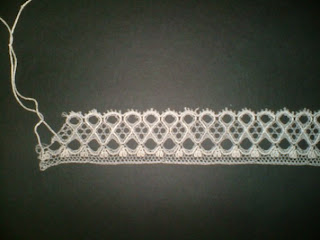Nancy's Big Heart of Denmark
Tonder is a city in Denmark (North Schleswig or South Jutland) that had an important lace industry in the 17th and 18th centuries. A complete history of the industry in the area can be found in Skovgard's Technique of Tonder Lace (11-24) and in Palliser's History of Lace (273-277). Please see the bibliography at the end of this post.
Toadstool, from Skovgaard's Techniques
One interesting story is that a young lacemaker named Kirstin Svendsdatter found a golden horn buried in the ground while she was walking to work one day. She wrote to King Christian IV, who gave the horn to his son. The king rewarded Kristin with enough money that she was able to marry her sweetheart and live happily ever after. The horn is made of sheet gold and is covered in runic inscriptions. It was probably a drinking horn, rather than a hunting horn, and a replica (the original was stolen and melted down) is now in the Danish National Museum in Copenhagen.
Christian IV is credited with improving and protecting the lace industry in Denmark. In the early 18th century, a group of lacemakers from Brabant in the Netherlands and Belgium settled in Tonder and added new motifs and grounds to the lace. By the beginning of the 19th century there were anywhere from 12,000 to 16,000 lacemakers (Skovgard, Technique, 17) to 20,000 lacemakers (Palliser, 275) in the Tonder area. Many lacemakers devoted their entire careers to making one specific pattern. "One widow, however, is recorded who lived to the age of eighty and brought up seven children on the produce of a narrow edging, which she sold at sixpence the yard" (Palliser, 276).
Eileen, from Skovgaard's Techniques
Bohnstedt, reconstructed by Bobbi from an antique lace
When cotton was introduced in the early 19th century, the industry was already declining. This may have been due to the changes in fashions brought on by the French Revolution, but also to the quality of the thread available. Coarser threads made for coarser laces, that were more quickly sold, but did nothing to improve the quality of the laces. After 1864, when Denmark was forced to give part of the Tonder area to Germany, many lacemakers quit making lace for both financial reasons and because they did not want their lace sold or displayed in Germany. It had always been a specifically Danish industry.
Nancy's Tonder handerchiefs
Lacemaking is celebrated in the Tonder region today. The Tonder Museum has a large collection of laces and lacemaking equipment and publishes books on the art. There is a lace festival every three years with exhibitions, lectures and workshops. The next one will be held June 7-9, 2013.
Bibliography
These are books I own - there are several others available, but many are out of print. See the IOLI library for more titles.
Hansen, Astrid. Femten Bredere Tonderkniplinger. Tonder Museum, 2004. 15 patterns with prickings, diagrams and photos, with an introduction. In Danish.
Nissen, Karen Trend. Knipling 3: Tonder-Knipling. Borgen, 1986. A very thorough primer on designing and working Tonder laces. In Danish, but an English translation is available. Many of these patterns are available completely diagrammed with prickings from Karelly Knipleservice in Denmark.
OIDFA, the International Bobbin and Needle Lace Organization. Point Ground Laces: a Comparative Study. OIDFA, 2001. A comparison of the different point ground laces, including Tonder.
Palliser, Mrs. Bury. History of Lace. Dover Publications, 1984. A history of most laces, including lots of photos.
Skovgaard, Inge. The Technique of Tonder Lace. Batsford, 1991. A wonderful introduction to Tonder lace, in English, but now out of print. Many beautiful patterns, from the simple to the complex, with photos, pricking, diagrams and working notes. The IOLI library has it available for members to borrow.
Skovgaard, Inge Wind. Tonderkniplinger I and Tonderkniplinger II. Forlaget akacia, 2002. Both of these books have great patterns, with prickings and diagrams. The text is only in Danish.
Southard, Doris. Lessons in Bobbin Lacemaking. Dover Publications, 1977. This is a classic introduction to bobbin lace with some information and pictures of Tonder laces towards the end of the book.
Tonder Tyl: 17 Monstre Med Arbejdstegniper. Knipling i Denmark, 1995. 17 patterns, with photos, diagrams and prickings, only in Danish.
Websites
Danish Lace Association. Most content in Danish
David Collyer, a gallery of Tonder lace he has made.
The Lace Fairy has some beautiful pictures of Tonder lace, pillows, and bobbins.
Happy Lacing!







I realize this is ancient history now, but I'm really interested in Tonder as a store of new designs using my Bucks point skills. Two of your gorgeous pictures refer to Nancy's work. Are her patterns available somewhere?
ReplyDeleteI am alos interested in Nacy's handkerchef edging.
ReplyDeleteAny possibility to make contact with her?
Manie Kriel, South Africa
mk52@mweb.co.za
I would like to know where I can find the Danish bobbins that have the beaded bulk at the bottom. I have a few and wold like to buy more but I don't see where you can buy them. Can you please put me in touch where I can buy some of the Tonder beaded bobbins. Than you so much!! Sherry
ReplyDelete